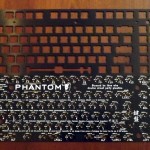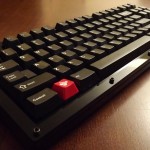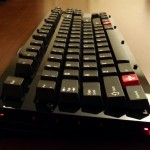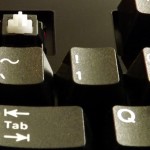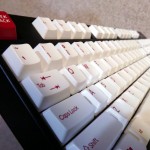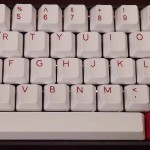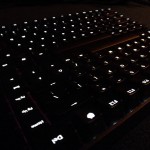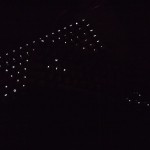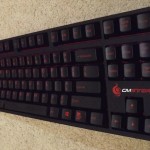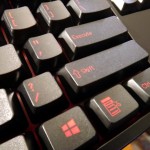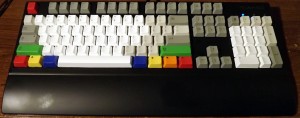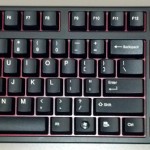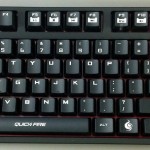Tag: Keyboards
The Phantom
by Russ Knize on Nov.19, 2012, under Keyboards
The Phantom keyboard is a community-driven keyboard project. The goal was to build a tenkeyless mechanical keyboard with customizable firmware that would fit into a Filco or similar case. The keyboard controller is a Teensy 2.0 and the key switches are Cherry MX. This build uses lubed “ergo-clear” switches and is mounted in an acrylic case from Litster on GeekHack. The key caps are double-shots from a Cherry G80 with a few novelty keys from the Cherry Replica project.
Tenkeyless Comparison
by Russ Knize on Nov.15, 2012, under Keyboards
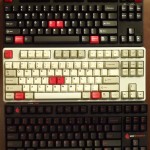
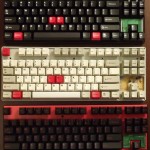 Here is a comparison of the internals of the 3 big tenkeyless boards that are often discussed and recommended at GeekHack and other forums: the Filco Majestouch 2 (aka MJ2), the CM Storm Quick Fire Rapid (aka QFR), and the Leopold FC200. From the outside, the similarities of the MJ2 and QFR case design are obvious. They are both made by Costar and therefore use Costar stabilizers. However feature-wise the MJ2 has an attached cable and separate caps/scroll lock LEDs, while the QFR and Leo have removable cables attached from under the case and integrated LEDs. The Leo uses Cherry stabilizers. A nice touch on the MJ2 is rubber feet on the rear legs, which most other keyboards on the market lack.
Here is a comparison of the internals of the 3 big tenkeyless boards that are often discussed and recommended at GeekHack and other forums: the Filco Majestouch 2 (aka MJ2), the CM Storm Quick Fire Rapid (aka QFR), and the Leopold FC200. From the outside, the similarities of the MJ2 and QFR case design are obvious. They are both made by Costar and therefore use Costar stabilizers. However feature-wise the MJ2 has an attached cable and separate caps/scroll lock LEDs, while the QFR and Leo have removable cables attached from under the case and integrated LEDs. The Leo uses Cherry stabilizers. A nice touch on the MJ2 is rubber feet on the rear legs, which most other keyboards on the market lack.
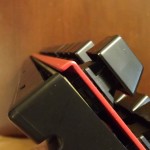 The MJ2 and the QFR use the exact same method to support the plate. The plate is curved downwards at the top and bottom, which rests on the base. The plate thickness is the same (0.055″) and both are made from steel. The cases are the same material and about the same thickness (~0.110″). The only interesting difference is that the MJ2 uses 2 screws to hold the plate down on the base. Both clamp the plate to the base with the top half of the case, which snaps together in the same way and are locked together with one screw.
The MJ2 and the QFR use the exact same method to support the plate. The plate is curved downwards at the top and bottom, which rests on the base. The plate thickness is the same (0.055″) and both are made from steel. The cases are the same material and about the same thickness (~0.110″). The only interesting difference is that the MJ2 uses 2 screws to hold the plate down on the base. Both clamp the plate to the base with the top half of the case, which snaps together in the same way and are locked together with one screw.
The Leo, on the other hand, has a plate that curves up and is supported by small ribs along the top and bottom. The plate thickness is the same, though, so this probably does not affect the feel of the board in any meaningful way. The case uses slightly thinner plastic, about 0.100″ – 0.105″ and snaps together with small tabs along the bottom edge (which make it much easier to open). It’s locked together with three screws.
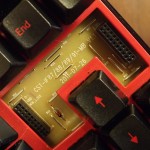 The QFR and the Leo use a single-sided FR2 ~0.06″ PCB while the Filco uses a double-sided FR4 0.065″ PCB. The MJ2 and QFR both use a header-mounted controller (though not compatible) while the Leo has the controller built onto the main PCB. The slightly thicker and denser PCB material on the FJ2 is the only major thing that sets it apart from the other two.
The QFR and the Leo use a single-sided FR2 ~0.06″ PCB while the Filco uses a double-sided FR4 0.065″ PCB. The MJ2 and QFR both use a header-mounted controller (though not compatible) while the Leo has the controller built onto the main PCB. The slightly thicker and denser PCB material on the FJ2 is the only major thing that sets it apart from the other two.
Click on the pictures for detailed comparisons.
Clearly Ergonomic
by Russ Knize on Nov.07, 2012, under Keyboards
The Cherry MX switch lineup is somewhat lacking a “quiet” tactile switch that is really tactile. As a buckling spring enthusiast, I find the MX blue switches highly annoying both in terms of sound and feel. The click has a very high-pitched tick and ring to it and the tactile feel has an odd disconnect from the time the key is registered. This might be because the reset point is above the actuation point. MX brown switches are not really all that tactile to begin with, but at least they register the press at a more intuitive moment and they don’t have that annoying tick. Cherry also has a more tactile version of their brown switch, which has a translucent “clear” stem. The springs are quite stiff, which makes them tiring to type on for any length of time.
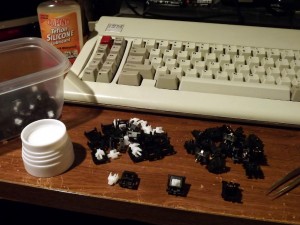 A very common Cherry MX switch modification in enthusiast circles is the so-called “ergo-clear” mod. This is where you combine the MX clear stem with the lighter spring from an MX blue/brown/red switch. I’ve decided, for me at least, that the ergo-clear provides the best typing experience that a Cherry MX switch can provide. It’s no buckling spring, but it comes close and is less noisy to boot.
A very common Cherry MX switch modification in enthusiast circles is the so-called “ergo-clear” mod. This is where you combine the MX clear stem with the lighter spring from an MX blue/brown/red switch. I’ve decided, for me at least, that the ergo-clear provides the best typing experience that a Cherry MX switch can provide. It’s no buckling spring, but it comes close and is less noisy to boot.
Usually, most of the work is getting into the switches. If the switches are already in a keyboard, they have to be desoldered if they are the plate-mounted variety. PCB mounted switches can be popped open without desoldering as long as the switch does not have integrated LEDs. I’ve done this to a few boards now, but this time I am working with loose switches.
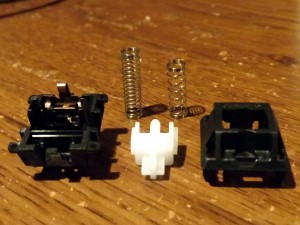 The switches are fairly easy to pry apart with a pair of small tweezers or similar tool. Some care is required during reassembly, but it is not that difficult. I also lube the stem guides with Silicone Teflon lubricant. This is a good idea with ergo-clears since the soft spring can have some difficulty overcoming the weight of the key and the friction of the tactile bump.
The switches are fairly easy to pry apart with a pair of small tweezers or similar tool. Some care is required during reassembly, but it is not that difficult. I also lube the stem guides with Silicone Teflon lubricant. This is a good idea with ergo-clears since the soft spring can have some difficulty overcoming the weight of the key and the friction of the tactile bump.
The soft spring is the longer one on the left.
Red Alert! (redux)
by Russ Knize on Aug.20, 2012, under Keyboards
This is the “Red Alert 2.0” key cap set that I got from a group buy on GeekHack. It is based on a similarly-named set that was run by KBTalking forums (Korea). While not quite as fancy, it still looks really sharp. It comes with red-on-white and white-on-red modifiers and Fn row.
- Rosewill RK9000 with white modifiers.
- KBC Poker with the red modifiers.
KBC Poker Center Support Modification
by Russ Knize on Aug.19, 2012, under Keyboards
This article was put into the GeekHack Wiki.
The KBC Poker X is a compact (60%) mechanical keyboard made by Vortex. Although it seems like it will be phased out and replaced by the Vortex Pure, it has a few advantages over it:
- The Poker uses completely standard key cap sizes so that any tenkeyless key set will work.
- The arrow keys are intuitively located both on the WASD cluster and on the lower-right modifiers.
It does have a few design problems, though. One is that the function lock on the Esc key (tilde) and on the lower-right nav keys is not reversible while holding Fn. Unfortunately, there is nothing that can be done about this. This is a particular problem when using vi or other cases where tilde is often used.
The other issue is a mechanical one. The PCB is mounted to the case at either end with screws, but there are no screws in the center. This causes the PCB to bow up slightly in the center, giving the keyboard a bouncy feel on the middle keys. Some folks have used a layer of thin foam between the PCB and the case to absorb this flex, but it doesn’t really address the root problem.
Vortex Race
by Russ Knize on Aug.08, 2012, under Keyboards
Here is the infamous Vortex “Race” 75% back lit keyboard. I’ve been using a KBC Poker X (a 60% keyboard) for a while with my laptop, so it is nice to have a real Fn row and a nav cluster of sorts. One has MX reds and the other MX browns. One or both will be “ergo-clear” modded at some point (MX clear stem with a blue/brown/red spring).
Here is the back lighting in action. It lets you set the brightness and lighting mode. One lame thing is that it forgets all the settings whenever it is reset. Another disadvantage is that it uses non-standard key cap sizes and profiles. So even if you give up the back lighting, you can only get other cap sets from Vortex. Vortex is a poorly-run company and I recommend avoiding working directly with them. Getting these turned into a bit of a mess over on GeekHack. The best thing is to buy them from a retailer that has them physically in stock.
- Both have white LEDs.
- Full lighting and WASD/Nav lighting.
Reds on Reds
by Russ Knize on Apr.24, 2012, under Keyboards
This is the CM Storm Quick Fire Rapid with Cherry MX red switches sporting double-shot “Ragnarok Red” key caps from signature plastics. Much better than the gaudy caps it comes with. They have more texture to them, too.
- Perfect for the CM Storm.
- Close up on the Rosewill.
Model M Cracked Frame Repair
by Russ Knize on Apr.06, 2012, under Keyboards
This was originally posted on GeekHack in the mods section before we were attacked by r00tworm. I’ll be moving it into the new Wiki at some point.
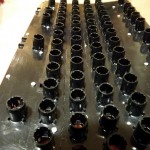 One of the Model M failures that is harder to deal with is cracking of the plastic plate that contains all of the key cap cylinders. Unicomp refers to this as the keyboard “frame”. Severe cracking is usually caused by extended use with broken rivets and/or severe abuse. Between each row are channels where the plastic is thin so that the frame can follow the contour of the backplate. The plastic gets brittle over time and will crack along these channels.
One of the Model M failures that is harder to deal with is cracking of the plastic plate that contains all of the key cap cylinders. Unicomp refers to this as the keyboard “frame”. Severe cracking is usually caused by extended use with broken rivets and/or severe abuse. Between each row are channels where the plastic is thin so that the frame can follow the contour of the backplate. The plastic gets brittle over time and will crack along these channels.
Custom Keyboard from WASD
by Russ Knize on Mar.14, 2012, under Keyboards
Here is a custom keyboard from WASD. This is their V1 with Cherry MX red switches, their snap-on wrist rest, and “50A-R” o-rings. The o-rings reduce the key travel slightly and soften the landing. The slight bounce of the rubber o-ring gives the linear MX red switch a bit of tactility. It is actually a nice compromise between typing and gaming, though they are a bit too soft for me to type fast.
I used their custom keyboard designer, which allowed me to customize the colors and legends of the ABS laser-etched keys. They can also laser-engrave, which I did on the WASD cluster (very helpful, BTW). I went with all symbols on the modifiers. Unfortunately, they were out of dark-gray 1.25 unit modifiers at the time. I did the RGBYO thing, instead. A bit gaudy, but whatever. The Futura font is nice.
Rainbow of Cherries
by Russ Knize on Feb.14, 2012, under Keyboards
My search for a mechanical keyboard that will be quiet enough for home use and yet comfortable to type on led me to geekhack.org. Filled with copious amounts of information about modern production mechanical keyboards, I decided to give some a try. Most of them produced today use switches from Cherry Corporation’s MX line. They use different stem colors to denote the different models. Mechanical keyboards have been coming back, thanks in large part to the gaming community. Four are commonly used switch types are:
- Blue – tactile with a audible click
- Brown – tactile with no click and lighter springs than the blue
- Black – linear with heavier springs than blue
- Red – linear with lighter springs (similar to brown)
There are lot of different brands out there with more coming all the time. In reality, there are only a few manufacturers making them. One of the best regarded, Filco, are made by Costar. Costar has been making boards for other brands using their reference design, which makes use of things like a steel plate that the switches mount to. In other words, you can get a “Filco” for much less than what a Filco-branded board costs.
The MX Brown seemed the most logical one to try first. It was a quiet switch with some tactile feel. I opted for the Rosewill RK-9000, which has a full 104 key set. It’s a very nice, solid board and I am extremely happy with it for typing. However, for gaming I found the tactile feel somewhat distracting. The bump in the stem that provides the feel also contributes a rough feel to the movement of the key.
To address this, I picked up a CM Storm Quick Fire Rapid with MX Red switches. I find this to be much better for gaming. It’s not quite as nice for typing, but it is still better than the previous keyboard I was using at home (Saitek Eclipse II). It is a “tenkeyless” model (no numeric keypad), which is a little weird at first. It’s perfectly fine for gaming, though. It comes with some extra keycaps for the WASD and “super” modifiers. The overall look of the keycaps is somewhat obnoxious. However, it’s still a Costar with a metal mount plate and all that. It is a solid board that just needs some better caps.
